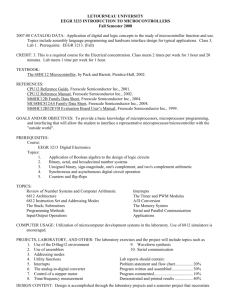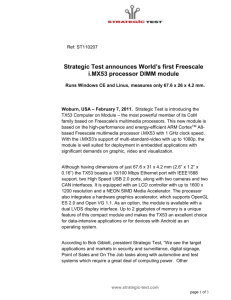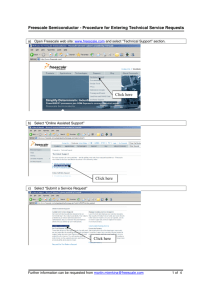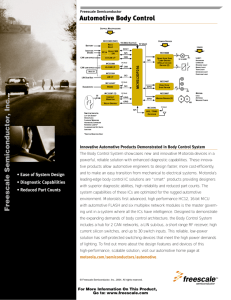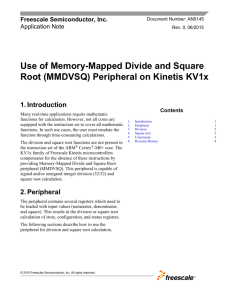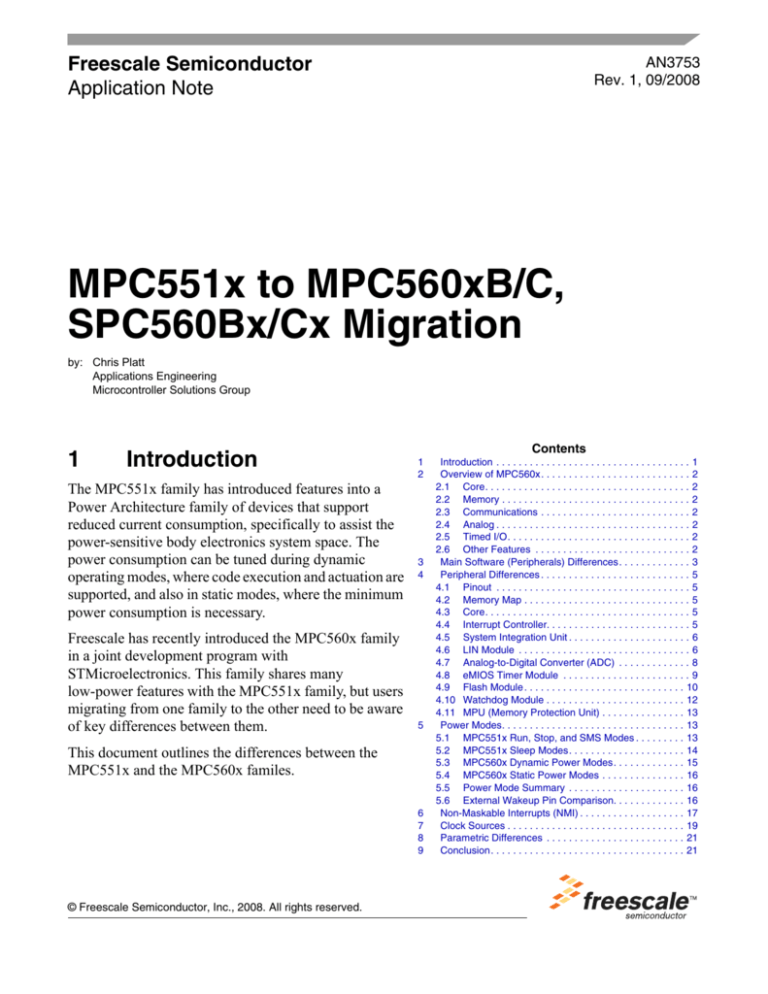
Freescale Semiconductor
Application Note
AN3753
Rev. 1, 09/2008
MPC551x to MPC560xB/C,
SPC560Bx/Cx Migration
by: Chris Platt
Applications Engineering
Microcontroller Solutions Group
1
Introduction
The MPC551x family has introduced features into a
Power Architecture family of devices that support
reduced current consumption, specifically to assist the
power-sensitive body electronics system space. The
power consumption can be tuned during dynamic
operating modes, where code execution and actuation are
supported, and also in static modes, where the minimum
power consumption is necessary.
Freescale has recently introduced the MPC560x family
in a joint development program with
STMicroelectronics. This family shares many
low-power features with the MPC551x family, but users
migrating from one family to the other need to be aware
of key differences between them.
Contents
1
2
3
4
5
This document outlines the differences between the
MPC551x and the MPC560x familes.
6
7
8
9
© Freescale Semiconductor, Inc., 2008. All rights reserved.
Introduction . . . . . . . . . . . . . . . . . . . . . . . . . . . . . . . . . . . 1
Overview of MPC560x. . . . . . . . . . . . . . . . . . . . . . . . . . . 2
2.1 Core. . . . . . . . . . . . . . . . . . . . . . . . . . . . . . . . . . . . . 2
2.2 Memory . . . . . . . . . . . . . . . . . . . . . . . . . . . . . . . . . . 2
2.3 Communications . . . . . . . . . . . . . . . . . . . . . . . . . . . 2
2.4 Analog . . . . . . . . . . . . . . . . . . . . . . . . . . . . . . . . . . . 2
2.5 Timed I/O. . . . . . . . . . . . . . . . . . . . . . . . . . . . . . . . . 2
2.6 Other Features . . . . . . . . . . . . . . . . . . . . . . . . . . . . 2
Main Software (Peripherals) Differences. . . . . . . . . . . . . 3
Peripheral Differences . . . . . . . . . . . . . . . . . . . . . . . . . . . 5
4.1 Pinout . . . . . . . . . . . . . . . . . . . . . . . . . . . . . . . . . . . 5
4.2 Memory Map . . . . . . . . . . . . . . . . . . . . . . . . . . . . . . 5
4.3 Core. . . . . . . . . . . . . . . . . . . . . . . . . . . . . . . . . . . . . 5
4.4 Interrupt Controller. . . . . . . . . . . . . . . . . . . . . . . . . . 5
4.5 System Integration Unit . . . . . . . . . . . . . . . . . . . . . . 6
4.6 LIN Module . . . . . . . . . . . . . . . . . . . . . . . . . . . . . . . 6
4.7 Analog-to-Digital Converter (ADC) . . . . . . . . . . . . . 8
4.8 eMIOS Timer Module . . . . . . . . . . . . . . . . . . . . . . . 9
4.9 Flash Module . . . . . . . . . . . . . . . . . . . . . . . . . . . . . 10
4.10 Watchdog Module . . . . . . . . . . . . . . . . . . . . . . . . . 12
4.11 MPU (Memory Protection Unit) . . . . . . . . . . . . . . . 13
Power Modes. . . . . . . . . . . . . . . . . . . . . . . . . . . . . . . . . 13
5.1 MPC551x Run, Stop, and SMS Modes . . . . . . . . . 13
5.2 MPC551x Sleep Modes. . . . . . . . . . . . . . . . . . . . . 14
5.3 MPC560x Dynamic Power Modes. . . . . . . . . . . . . 15
5.4 MPC560x Static Power Modes . . . . . . . . . . . . . . . 16
5.5 Power Mode Summary . . . . . . . . . . . . . . . . . . . . . 16
5.6 External Wakeup Pin Comparison. . . . . . . . . . . . . 16
Non-Maskable Interrupts (NMI) . . . . . . . . . . . . . . . . . . . 17
Clock Sources . . . . . . . . . . . . . . . . . . . . . . . . . . . . . . . . 19
Parametric Differences . . . . . . . . . . . . . . . . . . . . . . . . . 21
Conclusion. . . . . . . . . . . . . . . . . . . . . . . . . . . . . . . . . . . 21
2
Overview of MPC560x
Figure 1 shows a block diagram of the MPC560x device.
Here are the key features:
2.1
•
•
•
•
2.2
•
•
•
•
•
2.3
•
•
•
•
2.4
•
2.5
•
2.6
•
•
•
•
Core
PowerPC e200z0h core running 0–64 MHz
VLE ISA instruction set for superior code density
Vectored interrupt controller
Memory protection unit with eight regions, 32-byte granularity
Memory
512 KB embedded program flash, 64 KB data flash
64 KB embedded data flash (for EE emulation)
Up to 64 MHz nonsequential access with 3 WS
ECC-enabled array with error detect/correct
48 KB SRAM (single-cycle access, ECC-enabled)
Communications
Up to 6× enhanced FlexCAN with 64 message buffers each; full CAN 2.0 spec
4× LINFlex
3× DSPI, 8-16 bits wide and chip selects
1× IC
Analog
5 V 36-channel ADC 10-bit resolution (support down to 3 V with degraded performance)
Timed I/O
2×28 channel eMIOS module
Other Features
Debug: Nexus 2 + (208MPABGA package only)
I/O: 5 V or 3 V configurable I/O, high flexibility with selecting GPIO functionality
Packages: 100LQFP, 144LQFP (208MAPBGA development only)
Boot assist module for production and bench programming
MPC551x to MPC560xB/C, SPC560Bx/Cx Migration, Rev. 1
2
Freescale Semiconductor
VREG
SPC560Bx
e200Z0 Core
INTC
JTAG
NDI
(Optional)
Integer
Execution
Unit
Multiply
Unit
Instruction
Unit
VLE
General Purpose
Registers
(32×32-bit)
FMPLL
Oscillators
Branch
Unit
Watchdog
Load/Store
Unit
SIU
PIT
Instruction Bus
Data Bus
BAM
Crossbar Switch (XBAR)
Memory Protection Unit (MPU)
Peripheral Bridge
Flash
(ECC)
LINFlex
DSPI
ADC
I2 C
eMIOS200
FlexCAN
SRAM
(ECC)
Figure 1. SPC560Bxx Block Diagram
3
Main Software (Peripherals) Differences
Most of the modules on the MPC560x family are shared with the MPC551x family. Even so, there are
minor implementation differences which will be discussed later in this document. There are however three
major peripheral differences between the families. Figure 2 shows a block diagram of the MPC551x
family device with the main peripheral differences circled in red.
MPC551x to MPC560xB/C, SPC560Bx/Cx Migration, Rev. 1
Freescale Semiconductor
3
System
Integration
Crossbar Masters
Debug
JTAG
VReg
MCM
PIT 8ch 32b
Nexus
Class 2+
PowerPCTM
e200z1
Core
Osc/PLL
RTC
e200z0
Core
VLE
MMU
eDMA
Interrupt
Controller
FlexRay
Controller
VLE
CROSSBAR SWITCH
Memory Protection Unit (MPU)
Standby RAM
Up to 1Mb
Flash
Up to 64K
SRAM
EE Emulation
eMIOSLite
External
Bus
(optional)
Boot Assist
Module (BAM)
Crossbar Slaves
FlexCAN
DSPI
eSCI
I2C
Communications
I/O System
I/O
Bridge
QADC
Figure 2. MPC551x with Main Peripheral Differences Highlighted
The main differences are shown in Table 1.
Table 1. Major Differences Between MPC560x and MPC551x Families
MPC560x
MPC551x
ST 90nM
Freescale 0.13u
SCI
ST LINFlex controller
Freescale eSCI
ADC
ST ADC
Freescale QADC
No
Yes
No second core
Optional second core
Yes
No
Nexus 2+
Nexus 2+
Flash
eDMA
I/O Processor
Flexray Controller
Nexus
These differences will be discussed in more detail later in the document.
MPC551x to MPC560xB/C, SPC560Bx/Cx Migration, Rev. 1
4
Freescale Semiconductor
4
Peripheral Differences
4.1
Pinout
Since the two families do not use all of the same modules, and some of the modules which are common
between them are configured differently, the pinouts of the two families are not identical. Therefore it will
not be possible to simply replace an existing MPC551x part with a MPC560x device unless there is a PCB
modification.
4.2
Memory Map
Wherever possible on the MPC560x family, the peripherals are kept in the same place in the memory map
as in the MPC551x family. For example, RAM and FlexCAN occupy the same memory map space on both
families.
However, there are some memory map inconsistencies between the families, although this should largely
be transparent to the end user. This is because the compiler used to build the final application code will
ensure that reads and writes are performed correctly.
4.3
Core
The MPC551x family employs a dual core implementation, namely a Z1 and a Z0. The Z0 on this family
is essentially a stripped down Z1 — it runs only VLE code and has no MMU.
There is a single Z0 core on the MPC560x devices. However, it is not the same Z0 core as found on the
MPC551x family. The Z0 core on the MPC551x has a unified address and data bus (Von Neumann
architecture). The Z0 core on the MPC560x has separate address and data busses (Harvard architecture),
providing improved performance over the Z0 core on the MPC551x, and more in line with the Z1 core
found on the MPC551x.
This is another difference that should be somewhat transparent to the user.
4.4
Interrupt Controller
The interrupt controller found on the MPC560x family is the same as the one found on the MPC551x
devices, but with some important implementation differences.
Sixteen programmable priority levels are supported, but there are around 70 fewer vectors than on the
MPC551x family, mostly due to the different feature sets of the two families.
Some vectors are allocated differently, a difference which the user can handle in software. But when doing
so, the user needs to be aware of priority level allocation. For example, the DSPI, PITs, IIC, and DMA
interrupts are identical but exist at different locations.
Differences for the MPC560x family include:
• New vectors for new IP
• The addition of single-bit ECC error notification
• Missing vectors for unimplemented features
MPC551x to MPC560xB/C, SPC560Bx/Cx Migration, Rev. 1
Freescale Semiconductor
5
•
•
•
•
•
LINFlex provides separate Rx, Tx, and error vectors for each module
eMIOS interrupts are combined into groups of two channels
SIU external interrupt support is combined differently
FlexCAN interrupt arrangement efficiency is improved
Since the ADC module is different (FIFO versus results register), the interrupt support is also
different
4.5
System Integration Unit
The system integration unit (SIU) module on the MPC560x family is derived from the SIU found on
MPC551x and is referred to as the SIUL (SIU Lite) on the MPC560x parts. The SIU is the module which
is responsible for a variety of miscellaneous functions, including controlling the operation and
characteristics of the input and output pads on the device.
The GPIO operation of the SIUL remains consistent with the SIU found on MPC551x, and pads remain
controlled by the PCR register on a pad-by-pad basis. Figure 3 shows a pad configuration register for the
MPC560x.
There is a new control feature added for analog pad control which was not present on MPC551x, as well
as a bit for safe mode control (SMC) which can be used to set a particular pad to a known safe
configuration.
R
SMC
APC
0
0
PA
OBE
IBE
0
1
DSC
ODE
HYS
0
0
SRC
WPE WPS
W
Reset
0
0
0
0
0
0
0
0
0
0
Figure 3. Pad Configuration Register
On MPC560x, the function of the PA (pin assignment) bits is slightly different. These bits are used to select
the functionality of multiplexed pads. On MPC551x the PA bits were used for both input and output
functions. On MPC560x the PA bits are used only for output function selection. The input function
selection is now handled by the new Muxed input register [PSMI(n)].
Also supported in the SIUL are external interrupts (16 possible in both families) as well as wake up pads,
which are discussed later in the document. Input filtering is also supported on both families.
4.6
LIN Module
The LIN modules on the MPC551x and MPC560x are different. The former has the Freescale eSCI module
to provide its LIN functionality whilst the latter has the ST Micro LINFlex module.
Here we compare the two LIN modules.
4.6.1
•
•
eSCI (MPC551x)
LIN master mode and UART operating modes
Compliant with LIN 1.3, LIN 2.0, and LIN 2.1 specifications
MPC551x to MPC560xB/C, SPC560Bx/Cx Migration, Rev. 1
6
Freescale Semiconductor
•
•
•
•
•
•
•
4.6.2
•
•
•
•
•
•
•
•
•
Autonomous LIN frame handling when combined with DMA in master mode
If required, LIN slave mode may be implemented in software
LIN master mode state machine
Supports generation of LIN message header (break, sync, ID)
Detection and flagging of LIN errors
Bit; Checksum, CRC, physical stuck-at, overrun, and timeout errors
Classic or extended checksum calculation
LINFlex (MPCx)
LIN master, LIN slave, and UART operating modes
Compliant with LIN 1.3, LIN 2.0, and LIN 2.1 specifications
Handles autonomous LIN frame transmission and reception (can discard data in master mode
reception and slave mode)
Autonomous LIN frame handling even in stop mode
Message buffer to store identifier and up to eight data bytes
Detection and flagging of LIN errors
— Sync field
— Delimiter
— ID parity
— Bit
— Framing
— Checksum
— Overrun and timeout errors
Classic or extended checksum calculation
LIN slave mode features:
— Autonomous LIN header handling
— Autonomous LIN response handling
— Automatic resynchronization for slave mode operation with internal RC source clock
— Identifier filters for autonomous message handling
Fractional baud rate prescaler
Obviously, since the two modules are totally different, the register structure contained within them is also
totally different.
While both modules are fully compliant with the LIN 1.3, LIN 2.0, and LIN 2.1 specifications, the LINFlex
module found on MPC560x contains some enhancements over the eSCI, namely:
• Classic or extended checksum calculation
• Slightly enhanced detection and flagging of LIN errors
• Hardware support for LIN slave mode (internal message and ID buffers)
MPC551x to MPC560xB/C, SPC560Bx/Cx Migration, Rev. 1
Freescale Semiconductor
7
•
4.7
Identifier filters for autonomous message handling in slave mode
Analog-to-Digital Converter (ADC)
As with the LIN module, the ADC module on the MPC560x comes from ST Micro and is therefore
different from the ADC on MPC551x.
Table 2 shows a comparison between the two modules.
Table 2. Analog-to-Digital Converter Comparison
MPC551x
MPC560x
Resolution
12-bit/10-bit
10-bit
ADC Clock
Max 12 MHz
Max 20 MHz
Power sup
5.5 V
3 V to 5.5 V
Conv Time
1.25–11.83 μs
650 ns to 14.3 μs
< ±12 LSB (Prelim)
< ±2 LSB after offset canc.
IP Cap
0. 8 pF (ADC) 4 pF (PIN)
1.2 pF (ADC) 5 pF (PIN)
Current
4.5 mA
2 mA
10 μs
<1 μs
TUE
Start time
Figure 4 shows how the conversion principles differ between the two families.
MPC551x
chN to chM Conversion —
Single-Shot or Continuous per Channel Group
chN Conversion Command —
Single-Shot or Continuous per Channel
Memory —
Command Queue
Channel Conversion
Command
Channel/Mode
Control Bits
CPU/eDMA
ADC
CFIFO
ADC
CPU/eDMA
Memory —
Result Queue
RFIFO
Ch0
...
ChN
...
Ch39
Conversion
Result N to M
Ch0
...
ChN
...
ChM
...
Ch35
CPU/eDMA
Memory —
Result Queue
Figure 4. ADC Conversion Principle Comparison
Since the ADC converters are different (as discussed above), the pins required to operate the modules
differ too. Figure 5 shows a comparison of the pins between the two families.
MPC551x to MPC560xB/C, SPC560Bx/Cx Migration, Rev. 1
8
Freescale Semiconductor
MPC551x
MPC560x
Analog Supply Pins
RefH
VDDA
RefL
VSSA
REFBYPC
Analog Supply Pins
VDDA
4.5–5.25 V
VSSA
0–0.5 V
100 nF
RefH
Avdd33
Dvdd33
RefL
2.5–5 V
3–5.5 V
3–5.5 V
0–0.5 V
Analog Input Pins
Analog Input Pins
High Accuracy Channels,
.
.3
.
Ch 0–39
External Mux Control
Expandable to Channel 61
External Trigger
(External Pin, Timers)
. Ch 0–15 TUE < ±2 LSB
Accuracy Channels,
. Ch 16–35 High
TUE < ±2 LSB
.
. 3 External Mux Control
. Expandable to Channel 57
Trigger
. External
(External Pin, Timers)
Figure 5. ADC Pin Comparison
Some new features available on the MPC560x ADC not available on the MPC551x module are:
• Injected conversion:
— A continuing conversion sequence can be interrupted by a second one-shot sequence.
• Triggered injected conversion:
— An external or internal trigger (eMIOS, PIT) can start an injected conversion.
• Analog Watchdog:
— Allows continuous monitoring of four or eight analog input channels. An interrupt request is
generated whenever the converted value of one of these inputs is outside the upper or lower
programmed threshold values.
4.8
eMIOS Timer Module
The eMIOS timer system found on the MPC560x is based on the same module found on the MPC551x
family but configured quite differently. It also has a new mode, OPWMT (OPWM with trigger generation),
supporting shifted PWM and trigger generation to synchronize ADC conversion with the PWM signal.
Whilst the MPC551x family contains a single eMIOS module with 24 channels and 16 bit counter busses,
the MPC560x features two separate eMIOS instantiations, each with 28 channels for a total of 56 available
channels.
The start of both eMIOS modules can be synchronized, and all 50 output PWM channels are connected to
the new cross triggering unit lite (CTUL) (not found on MPC551x), which allows the channels to be used
to trigger ADC conversion synchronously to the PWM channels and without any CPU intervention.
The ADC trigger conversion can be configured for each OPWMT channel anywhere in the PWM period.
This is ideal for lighting applications, to implement synchronous analog diagnostic of power switches in
TOn and TOff states.
MPC551x to MPC560xB/C, SPC560Bx/Cx Migration, Rev. 1
Freescale Semiconductor
9
The MPC560x eMIOS configuration is shown in Figure 6.
eMIOS0
eMIOS1
Figure 6. MPC560x eMIOS Configuration
4.9
Flash Module
Since the two families are manufactured by different technologies, the flash memory modules are a little
different.
Both modules incorporate ECC (error correction code) on each 64 bits of flash memory, but the flash on
the MPC560x now has the added feature of single bit error visibility.
Both families implement data flash with multiple 16K flash blocks using standard flash cell with ECC.
Both also support program and erase operations with a state machine. The two families have different data
flash configurations (shown below) and different positions in the memory map.
Read while write is supported slightly differently on MPC560x, through a separate flash array
implementation. This restricts operation compared to MPC551x, where two partitions are supported in the
data flash.
Figure 7 and Figure 8 show the relative flash configurations of the MPC551x and MPC560x families.
MPC551x to MPC560xB/C, SPC560Bx/Cx Migration, Rev. 1
10
Freescale Semiconductor
R-W-W
Partition
R-W-W
Partition
128K
64K
Main Code
64K
16K
R-W-W
Partition
16K
Potential Boot Area
and/or Calibration/
Configuration Data
16K
16K
EEPROM
Emulation
16K
R-W-W
Partition
16K
16K
Potential Boot Area
and/or Calibration/
Configuration Data
16K
Figure 7. Flash Configuration on MPC551x
16K
R-W-W
Partition
16K
Data Flash
16K
16K
128K
128K
Main Code
32K
R-W-W
Partition
32K
16K
Potential Boot Area
and/or Calibration/
Configuration Data
16K
32K
Figure 8. MPC560x Flash Configuration
MPC551x to MPC560xB/C, SPC560Bx/Cx Migration, Rev. 1
Freescale Semiconductor
11
Flash accesses are similar between the two families, with the MPC551x having two sets of 4×128-bit page
buffers, compared to the MPC560x devices which have only a single 128-bit page buffer for accesses to
the data flash.
The Z1 core on the MPC551x family could access the flash through the crossbar switch but also had a
direct port to access the flash memory. On the MPC560x family all flash accesses must go through the
crossbar switch (see Figure 9).
AHB Crossbar Switch
32
PFLASH Controller
1×128-Bit Page Buffer
128
64K Data Flash
4×128-Bit Page Buffer
128
512K Code Flash
Array 0
Array 0
Bank 1
(Data Flash)
Bank 0
(Code Flash)
Figure 9. MPC560x — Flash Access Configuration
The write/erase cycles and data retention performance of both the MPC551x and the MPC560x flash
blocks are planned to be comparable, but there is currently insufficient data for the MPC560x flash to print
fully characterized data at this time.
4.10
Watchdog Module
The MPC560x parts have a new watchdog module on board which offers some improved safety features
over the watchdog module on MPC551x.
The watchdog modules support standard and windowed operating modes. The watchdog module is
enabled out of reset but can be disabled as required.
Writes to the service register hold off the watchdog.
MPC551X — 0x55 followed by 0xAA
MPC551x to MPC560xB/C, SPC560Bx/Cx Migration, Rev. 1
12
Freescale Semiconductor
MPC560x — 0xA602 followed by 0xB480
There is protection against inadvertent modification with optional soft locks and hard locks. Soft locks
allow temporary locking of configuration; a hard lock, once it’s enabled, prevents any changes until after
a reset. There is also a configurable timeout time as well as response type on timeout, i.e., reset, interrupt,
or interrupt followed by a reset.
4.11
MPU (Memory Protection Unit)
The MPU on the MPC551x devices contains 16×128-bit descriptors, whereas the MPU on MPC560x has
8×128-bit descriptors.
5
Power Modes
Since both families are specifically designed to be used in power sensitive applications, various low-power
modes are available for selection by the user to minimize overall current consumption.
The power modes of both device families are shown in detail here.
5.1
5.1.1
•
•
5.1.2
•
MPC551x Run, Stop, and SMS Modes
Complete Microcontroller System
Z1RUN
— Traditional full run mode
— All of the device is powered and RAM access is available
— Z1 is allowed to execute
— User can disable Z0 and any modules, hence inhibiting clock to specific modules
— Power estimate: < 125 mA (all parameters are for indication only — committed values will be
found in the current datasheet)
Z1STOP
— Traditional full stop mode
— All of the device is powered and RAM is retained
— I/O processor and Z1 held in halt mode
— All peripherals clock-gated off
— Power estimate: < 400 μA @ 25 °C
Small Microcontroller System (Achievable by Software)
SMS Functionality
— Use active clock gating to segment the device
— Select either Z0 or Z1 as principal core
— Clock the applicable core and a small peripheral set
MPC551x to MPC560xB/C, SPC560Bx/Cx Migration, Rev. 1
Freescale Semiconductor
13
•
•
5.2
•
•
•
•
•
•
•
•
— Clock-gate off the remaining peripherals and other core
SMSRUN
— All RAM retained and access is available
— Selected processor and peripheral configuration automatically restored from RAM
— Selected processor allowed to execute
— Power estimate: 10 mA based on 16 MHz internal RC
SMSSTOP
— All RAM retained
— Selected processor and peripheral configuration automatically stored into RAM
— Peripherals and processor powered down
— Power estimate: <100 mA @ 25 °C (supported through software reconfiguration)
MPC551x Sleep Modes
All power disabled to device except low power Vreg
Uses aggressive power gating to minimize leakage
Scalability of retained RAM for maximum customer flexibility
Separate RAM power regulator to further reduce RAM leakage
Pad keepers — output states retained (register values lost)
Eight external wakeup sources
Optional autonomous periodic interrupt (API), available in all sleep modes
— Supports 1 ms to 1 hour wakeup capability
— Incrementally consumes only 2 μA when enabled with on-chip 32 KHz IRC
Optional RTC wakeup capability for even longer timeout
— Supports 1 second to 24 hour wakeup periods
— Incrementally consumes only 2 μA when enabled with on-chip 32 KHz IRC
Sleep mode configurations and estimates:
•
•
•
•
•
•
All I/O states with full wakeup capability on selected I/O
Power estimate: ~25 μA @ 25 °C + approximately 5 μA per 8K extra RAM
8K RAM retained and all I/O states
16K RAM retained and all I/O states
32K RAM retained and all I/O states
64K RAM retained and all I/O states
The MPC560x devices have similar modes but with slightly different functionality in each mode, as shown
below.
MPC551x to MPC560xB/C, SPC560Bx/Cx Migration, Rev. 1
14
Freescale Semiconductor
5.3
5.3.1
MPC560x Dynamic Power Modes
Run Modes (0–3)
These are the main software running modes where most processing activity is done. These various run
modes allow enablement of different clock and power configurations of the system, with respect to each
other.
• Traditional full run mode
• RAM access available
• Z0 allowed to execute
• Multiple (four) run configurations with different clock and feature sets
• Offers rapid run mode change, to quickly change dynamic power and performance
• Four mode configuration registers hold the setup
5.3.2
•
•
•
5.3.3
DRUN (Default Run) Mode
Entry mode for the embedded software — provides full system accessibility and enables system
configuration; provides gate to enter user modes
BAM (when present) is executed in DRUN mode
Power estimate: < 100 mA
Wait Mode
CPU is stopped and clock is gated, with all peripherals remaining at normal full-speed operation
• Intended for short duration suspension of processing while allowing peripheral operations to
continue
• Interrupt offers wakeup to core, to allow fast restart of CPU activity
5.3.4
Halt Mode
Reduced-activity low-power mode during which the core clock is disabled. Can be configured to switch
off analog peripherals for efficient power management, at the cost of higher wakeup latency.
• Device continues to operate but with core clock gated, halting CPU processing
• Peripherals can continue to run at normal or reduced frequency
• Analog device components can be stopped, such as PLL, ADC, and main Vreg
• Flash can be turned off to save power
• PLL can be configured to be on or off (default is off)
MPC551x to MPC560xB/C, SPC560Bx/Cx Migration, Rev. 1
Freescale Semiconductor
15
5.4
5.4.1
MPC560x Static Power Modes
Stop Mode
Stop mode is an advanced low-power mode during which the clock to the core is disabled and main
peripherals are all stopped.
• Use active clock gating to segment the device
• External oscillator stopped, but can be allowed to continue to run to support fast startup and the
expense of added power
• All of device is powered and RAM is retained
• RTC and API can continue to run
• PLL always off
• Optional support of fast IRC and slow IRC
• Power estimate: < 180 μA @ 25 °C
5.4.2
Standby Mode
Provides the minimum power consumption mode for the MPC560x. In this mode power is cut off from
most of device, with only a small power island retained. Wakeup requires recovery time for clocks and
power supply.
• Recovery of data needed on exit from mode, with context saved prior to mode entry
• Selectable size of RAM supported: 8K or all RAM
• Optionally enabled low-speed IRC
• Wakeup from selected I/O or API/RTC
• Power estimate: All RAM retained < 50 μA @ 25 °C
• Power estimate: 8K RAM retained < 25 μA @ 25 °C
5.5
Power Mode Summary
In summary, both families have very similar regular run modes.
Both families have a halt mode which allows clock gating to the core and the peripherals. The operation
of this mode is the same on both families.
Both families have an identical stop mode.
MPC551x has multiple sleep modes with varying amounts of RAM kept powered. MPC560x has standby
mode which is essentially the same as sleep mode but using the ST naming convention. Only 0K or 8K
RAM is selectable to be kept alive in this mode.
5.6
External Wakeup Pin Comparison
Both families have the ability to wake from low-power modes triggered by transitions on external pins.
MPC551x to MPC560xB/C, SPC560Bx/Cx Migration, Rev. 1
16
Freescale Semiconductor
On MPC551x, eight external wakeup pins can be configured using a multiplexer to select from a pool of
64 possible pins.
By comparison, the MPC560x devices allow 18 fixed external wakeup pins to be supported at any one
time, as shown in Figure 10 below.
Wake-up Unit
RTC / API
PA[0]
PA[1] / NMI
PA[2]
PB[1] / CANRX_0
PC[11] / CANRX_1 / CANRX_4
PE[0] / CANRX_5
PE[9] / CANRX_2 / CANRX_3
Wake-up_0
(Int Vec 46)
PB[10] / CANRX_0
PA[4] / RXD_5
PA[15] / PCS0_0/ SCK_0
PB[3] / RXD_0 / SCL_0
PC[7] / RXD_1
PC[9] / RXD_2 / PCS3_4
PE[11] / RXD3_3 / PCS1_4
PF[11] / RXD_4
Wake-up_1
(Int Vec 46)
PF[13] / RXD_5
PG[7] / RXD_6
PG[9] / RXD_7
Wake-up_2
(Int Vec 46)
Figure 10. Wakeup Pin Assignment
6
Non-Maskable Interrupts (NMI)
Both families offer the ability to utilize a non-maskable interrupt function. However, the feature is
achieved in slightly different ways on the two families.
Figure 11 shows how the function is achieved on MPC551x. The NMI bypasses the interrupt controller
and is instead routed from external pins to the critical interrupts for the two cores (Z0 & Z1). Once enabled
in the SIU, the NMI function cannot be blocked by re-configuring the pad in the SIU.
MPC551x to MPC560xB/C, SPC560Bx/Cx Migration, Rev. 1
Freescale Semiconductor
17
DIRS1
SIU_DIRSR
SIU_EISR
External
IRQ pins or
internal
sources
PD11
PD10
IMUX
•
•
•
•
EIF0
EIF1
EIF2
EIF3
EIF4
•
•
EIF15
DIRS1
DIRS2
DIRS3
DIRS4
•
•
DMA/Interrupt Select
SIU
DMA
request
DIRS2
eDMA
DIRS3
DIRS4
Interrupt
request
DIRS1
DIRS2
DIRS3
DIRS4
Interrupt
controller
EIF5–EIF15
NMI1
NMI0
SIU_OSR
OVF0
OVF1
•
•
•
•
•
•
Overrun
request
Secondary
CPU
Critical
interrupt
OVF15
Primary
CPU
Figure 11. NMI Architecture on MPC551x
Figure 12 shows how the NMI is set up on the MPC560x parts. The NMI is configured in the NMI
configuration register (NCR). Once enabled, the SIUL cannot reconfigure the allocation of this pin to
inhibit the NMI.
There are three NMI types on MPC560x.
•
•
•
Critical Interrupt (same as MPC551x)
— Recoverable NMI, but can be blocked by CE bit in core MCR
Machine Check Exception
— Cannot be masked, but nonrecoverable
– Other MCE can occur and overwrite the CSRR[x]
Machine Check Exception
— As above, but NMI held to prevent other critical exception from occurring and overwriting the
save restore register values
MPC551x to MPC560xB/C, SPC560Bx/Cx Migration, Rev. 1
18
Freescale Semiconductor
Machine Check
Critical IRQ
NMI
CPU
Destination
Wakeup Enable
Overrun
Flag
Edge Detect
Glitch Filter
NFE
NFEE
NREE
NWRE
NDSS
NMI
Figure 12. MPC560x NMI Architecture
7
Clock Sources
The two families have almost identical clock sources available to them.
Both have a main external oscillator input (4–40 MHz input on MPC551x, 4–16 MHz input on MPC560x).
Both also have an on-chip 16 MHz fast RC oscillator which can be used to drive the main system clock.
Both have an onboard slow oscillator which runs at 32 KHz on MPC551x and 128 KHz on MPC560x.
They also both have an external 32 KHz crystal source available to drive certain peripherals and onboard
timers.
Figure 13 and Figure 14 show the two clocking schemes.
MPC551x to MPC560xB/C, SPC560Bx/Cx Migration, Rev. 1
Freescale Semiconductor
19
SYSCLKSEL (SIU_SYSCLK)
Bypass Clock
XOSC
oscclk
PLL
LPCLKDIV (SIU_SYSCLK)
2
System Clock
1
/1,2,4,8
16MHz_IRC
0
Cores, INTC, DMA, SIU, RAM,
Flash, BAM, AIPS, AXBS, MCM
Sys clock
divider
Peripheral
Dividers/1,2,4
Ipg_clk
Sys clock
16MIRCSTOP
IRCTRIM switcher
Ipg_clk_s
FlexRay
Module Clock
Ipg_clk_s
FlexCAN_A
DSPI_A
Group0
ESCI_A
IIC_A
PIT_RTI
Group1
FlexCAN_B-F
Group2
Ipg_clk
DSPI_B-C
Group3
Ipg_clk
ESCI_B-H
Group4
Ipg_clk
eMIOS
Group5
Rsvd
Group6
Prot Clk
Ipg_clk
Ipg_clk
Ipg_clk_s
Module Clock
Prot Clk
Ipg_clk_s
Ipg_clk_s
RTC and API
32KHz_Osc
Ipg_clk_s
RTC, API, CQC
Ipg_clk_s
32KHz_IRC
IRCTRIM
Ipg_clk_s
Ipg_clk
Ipg_clk_s
Ipg_clk
Gated by
MDIS
Figure 13. MPC551x Clocking Scheme
XOSC
4–16 MHz
IRC Fast
16 MHz
osca_clk_div
system_clk
Div 1 to 32
irc_fast_div
Div 1 to 32
FMPLL
System
Clock
Selector
Core
Platform
Div 1 to 15
Peripheral Set 1
(LINFlex, I2C)
Div 1 to 15
Peripheral Set 2
(FlexCAN, DSPI)
Div 1 to 15
Peripheral Set 3
(eMIOS, BCTU, ADC)
Div 1/2/4/8
Clock Out
fmplla_clk
irc_fast
osca_clk
irc_slow
CMU
osca_clk
irc_fast
fmplla_clk
RESET
SAFE
INT
CLKOUT
Selector
SWT
(Watchdog)
IRC Slow 128 KHz
Div 1 to 32
LP XOSC 32 KHz
Div 1 to 32
irc_slow_div
irc_fast_div
oscb_clk_div
API/RTC
Figure 14. MPC560x Clocking Scheme
MPC551x to MPC560xB/C, SPC560Bx/Cx Migration, Rev. 1
20
Freescale Semiconductor
8
Parametric Differences
Since the two product families are built with different technologies, parametric differences will almost
certainly be apparent in most areas.
All parameters quoted in this document are for indication only. Parametric data for MPC560x is available
in the preliminary datasheet. Please refer to that document for committed values.
9
Conclusion
Despite being built with two different technologies, the MPC551x and MPC560x families share so many
common peripherals, features, and tools that transitioning to the MPC560x family from the MPC551x
family should prove a relatively simple task, if the user takes account of the differences outlined in this
document.
MPC551x to MPC560xB/C, SPC560Bx/Cx Migration, Rev. 1
Freescale Semiconductor
21
How to Reach Us:
Home Page:
www.freescale.com
Web Support:
http://www.freescale.com/support
USA/Europe or Locations Not Listed:
Freescale Semiconductor, Inc.
Technical Information Center, EL516
2100 East Elliot Road
Tempe, Arizona 85284
1-800-521-6274 or +1-480-768-2130
www.freescale.com/support
Europe, Middle East, and Africa:
Freescale Halbleiter Deutschland GmbH
Technical Information Center
Schatzbogen 7
81829 Muenchen, Germany
+44 1296 380 456 (English)
+46 8 52200080 (English)
+49 89 92103 559 (German)
+33 1 69 35 48 48 (French)
www.freescale.com/support
Japan:
Freescale Semiconductor Japan Ltd.
Headquarters
ARCO Tower 15F
1-8-1, Shimo-Meguro, Meguro-ku,
Tokyo 153-0064
Japan
0120 191014 or +81 3 5437 9125
support.japan@freescale.com
Asia/Pacific:
Freescale Semiconductor China Ltd.
Exchange Building 23F
No. 118 Jianguo Road
Chaoyang District
Beijing 100022
China
+86 10 5879 8000
support.asia@freescale.com
Freescale Semiconductor Literature Distribution Center
P.O. Box 5405
Denver, Colorado 80217
1-800-441-2447 or +1-303-675-2140
Fax: +1-303-675-2150
LDCForFreescaleSemiconductor@hibbertgroup.com
Document Number: AN3753
Rev. 1
09/2008
Information in this document is provided solely to enable system and software
implementers to use Freescale Semiconductor products. There are no express or
implied copyright licenses granted hereunder to design or fabricate any integrated
circuits or integrated circuits based on the information in this document.
Freescale Semiconductor reserves the right to make changes without further notice to
any products herein. Freescale Semiconductor makes no warranty, representation or
guarantee regarding the suitability of its products for any particular purpose, nor does
Freescale Semiconductor assume any liability arising out of the application or use of any
product or circuit, and specifically disclaims any and all liability, including without
limitation consequential or incidental damages. “Typical” parameters that may be
provided in Freescale Semiconductor data sheets and/or specifications can and do vary
in different applications and actual performance may vary over time. All operating
parameters, including “Typicals”, must be validated for each customer application by
customer’s technical experts. Freescale Semiconductor does not convey any license
under its patent rights nor the rights of others. Freescale Semiconductor products are
not designed, intended, or authorized for use as components in systems intended for
surgical implant into the body, or other applications intended to support or sustain life,
or for any other application in which the failure of the Freescale Semiconductor product
could create a situation where personal injury or death may occur. Should Buyer
purchase or use Freescale Semiconductor products for any such unintended or
unauthorized application, Buyer shall indemnify and hold Freescale Semiconductor and
its officers, employees, subsidiaries, affiliates, and distributors harmless against all
claims, costs, damages, and expenses, and reasonable attorney fees arising out of,
directly or indirectly, any claim of personal injury or death associated with such
unintended or unauthorized use, even if such claim alleges that Freescale
Semiconductor was negligent regarding the design or manufacture of the part.
RoHS-compliant and/or Pb-free versions of Freescale products have the functionality
and electrical characteristics as their non-RoHS-compliant and/or non-Pb-free
counterparts. For further information, see http://www.freescale.com or contact your
Freescale sales representative.
For information on Freescale’s Environmental Products program, go to
http://www.freescale.com/epp.
Freescale™ and the Freescale logo are trademarks of Freescale Semiconductor, Inc.
All other product or service names are the property of their respective owners.
The Power Architecture and Power.org word marks and the Power and Power.org logos
and related marks are trademarks and service marks licensed by Power.org
© Freescale Semiconductor, Inc. 2008. All rights reserved.

